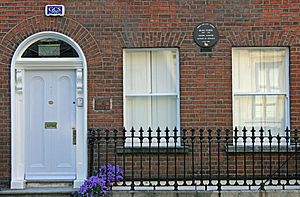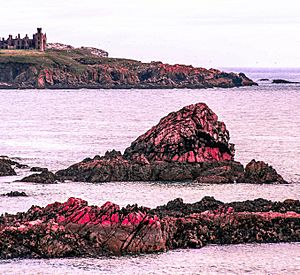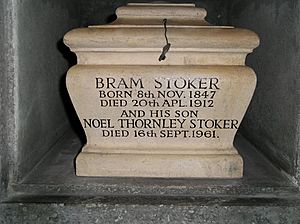Bram Stoker facts for kids
Quick facts for kids
Bram Stoker
|
|
|---|---|
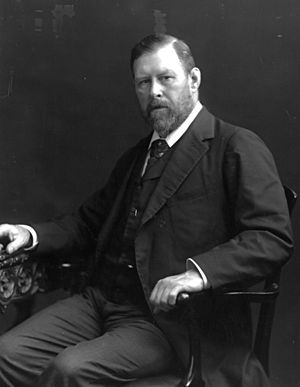
Stoker c. 1906
|
|
| Born | 8 November 1847 Clontarf, Dublin, Ireland |
| Died | 20 April 1912 (aged 64) Pimlico, London, England |
| Occupation | Novelist |
| Alma mater | Trinity College Dublin |
| Period | Victorian era, Edwardian era |
| Genre | Gothic fiction, romantic fiction |
| Literary movement | Dark romanticism |
| Notable works | Dracula |
| Spouse |
Florence Balcombe
(m. 1878) |
| Children | 1 |
| Signature | |
Abraham Stoker (born November 8, 1847 – died April 20, 1912) was an Irish writer. He is most famous for his 1897 horror novel Dracula. During his life, he was better known as the personal assistant to the famous actor Sir Henry Irving. He also managed the Lyceum Theatre in London, which Irving owned.
In his younger years, Stoker worked as a theatre critic for an Irish newspaper. He also wrote stories and commentaries. He loved to travel, especially to Cruden Bay in Scotland, where he set two of his novels. During another trip to the English coastal town of Whitby, Stoker found ideas for writing Dracula. He passed away on April 20, 1912, after an illness. His ashes were placed in north London. Since his death, Dracula has become one of the most famous books in English literature. It has been made into many films, short stories, and plays.
Contents
Early Life of Bram Stoker
Stoker was born on November 8, 1847, in Clontarf, Ireland. The park next to his childhood home is now called Bram Stoker Park. His parents were Abraham Stoker and Charlotte Mathilda Blake Thornley. Bram was the third of seven children. His family belonged to the Church of Ireland. His father, Abraham, was a senior government worker.
Stoker was sick and stayed in bed until he was seven years old. After that, he made a full recovery. He later wrote that this time of illness gave him "many thoughts" that helped him in later life. He was taught at home by a private tutor.
After getting better, he grew up healthy. He even became a great athlete at Trinity College, Dublin, where he studied from 1864 to 1870. He earned his first degree in 1870. He was named University Athlete and played rugby for Dublin University. He was also a leader in two important student societies.
Stoker's Early Career
Stoker became interested in theatre when he was a student. While working for the Irish government, he became a theatre critic for the Dublin Evening Mail newspaper. This newspaper was partly owned by Sheridan Le Fanu, who wrote Gothic stories. Theatre critics were not highly respected back then, but Stoker's reviews were very good.
In 1876, he wrote a positive review of Henry Irving's play Hamlet. Irving then invited Stoker to dinner, and they became friends. Stoker also wrote short stories. His story "Crystal Cup" was published in 1872. He also wrote a non-fiction book about government work in Ireland. In 1879, he helped start the Dublin Sketching Club, showing his interest in art.
Working at the Lyceum Theatre
In 1878, Stoker married Florence Balcombe. She was known for her beauty. The Stokers then moved to London. Stoker became the business manager of Irving's Lyceum Theatre, London. He held this job for 27 years. On December 31, 1879, Bram and Florence had their only child, a son named Irving Noel Thornley Stoker.
Working with Henry Irving was very important for Stoker. Through Irving, he met many important people in London society. He met artists like James Abbott McNeill Whistler and writers like Sir Arthur Conan Doyle. Managing one of London's most successful theatres made Stoker a well-known and busy man. He greatly admired Irving. In London, Stoker also met Hall Caine, who became one of his closest friends. Stoker dedicated Dracula to him.
Stoker traveled the world during Irving's theatre tours. He never visited Eastern Europe, which is where his most famous novel is set. Stoker enjoyed visiting the United States, where Irving was popular. He was even invited to the White House twice. He met American presidents William McKinley and Theodore Roosevelt. Stoker set two of his novels in America and included American characters in his books. He also met his literary hero, Walt Whitman.
Bram Stoker in Cruden Bay
Stoker visited Cruden Bay in Scotland often between 1892 and 1910. His month-long holidays there gave him a lot of time to write his books. Two of his novels, The Watter's Mou' (1895) and The Mystery of the Sea (1902), are set in Cruden Bay. He started writing Dracula there in 1895. The guest book from the hotel where he stayed still has his signatures.
The nearby Slains Castle is thought to have inspired Stoker's descriptions of Castle Dracula. A unique octagonal room in Slains Castle matches the description of a room in Castle Dracula.
Stoker's Writings
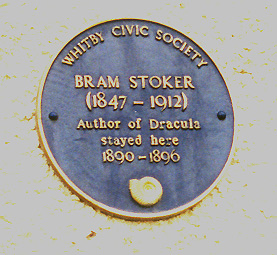
Stoker visited the English coastal town of Whitby in 1890. This visit is said to have inspired parts of Dracula. He began writing novels while working as a manager for Irving. His first novel was The Snake's Pass in 1890, followed by Dracula in 1897. During this time, Stoker also worked for The Daily Telegraph newspaper in London. He wrote other horror novels, like The Lady of the Shroud (1909) and The Lair of the White Worm (1911). After Irving's death, Stoker published his memories of him in a book called Personal Reminiscences of Henry Irving (1906), which was very popular.
Before writing Dracula, Stoker met Ármin Vámbéry, a Hungarian writer and traveler. Some believe Vámbéry's stories about the Carpathian mountains might have inspired Dracula. However, some experts, like Elizabeth Miller, say there is no clear evidence of this. Stoker was already using the name Dracula for his vampire character by then. He spent several years researching European folklore and vampire myths.
The book In Search of Dracula (1972) suggested that Count Dracula was based on Vlad III Dracula, a real historical figure. However, Elizabeth Miller states that Stoker only borrowed the name and some small facts about Romanian history. There are no notes from Stoker about Vlad III in his research.
Dracula is written as an epistolary novel. This means it is told through a collection of fictional diary entries, telegrams, letters, ship logs, and newspaper clippings. This style made the story feel very real. When it was first published, Dracula was seen as a "straightforward horror novel." It gave shape to a common fantasy and became a big part of popular culture.
Stoker's stories are now considered horror fiction, romantic Gothic tales, and melodramas. They are often compared to other popular books like Mary Shelley's Frankenstein. Both novels use the method of having multiple narrators tell the same story from different viewpoints. This makes the reader believe that "they can't all be lying."
The original typed manuscript of Dracula, which was 541 pages long, was thought to be lost. It was found in a barn in Pennsylvania in the early 1980s. The title page had "THE UN-DEAD" written on it. The manuscript was bought by Microsoft co-founder Paul Allen.
Besides Whitby, Stoker's ideas for the story might have come from a visit to Slains Castle in Scotland. He also visited the crypts of St. Michan's Church in Dublin. Another possible inspiration was the novella Carmilla by Sheridan Le Fanu, which is also about vampires.
Stoker's original research notes for Dracula are kept at the Rosenbach Museum and Library in Philadelphia.
Stoker at The London Library
Stoker was a member of The London Library. He did much of his research for Dracula there. In 2018, the Library found some of the books Stoker used for his research. These books even had his notes written in the margins.
Death and Legacy
After several health problems, Stoker passed away in London on April 20, 1912. He was cremated, and his ashes were placed in an urn at Golders Green Crematorium in north London. His son's ashes were added to his father's urn after his death in 1961.
Stoker's Beliefs
Stoker was raised as a Protestant. He strongly supported the Liberal Party in politics. He was very interested in Irish affairs. He believed in Home Rule for Ireland, but only if it happened peacefully. He also believed Ireland should stay part of the British Empire, which he saw as a positive force. He admired Prime Minister William Ewart Gladstone and supported his plans for Ireland.
Stoker believed in progress and was very interested in science and medicine. Some of his novels, like The Lady of the Shroud (1909), are early examples of science fiction. He was interested in the occult, like mesmerism, but he disliked fraud. He believed that the scientific method was better than superstition.
After Stoker's Death
The short story collection Dracula's Guest and Other Weird Stories was published in 1914 by Stoker's wife, Florence Stoker. She was in charge of his literary works. The first film based on Dracula was Nosferatu, released in 1922. Florence Stoker sued the filmmakers because they did not ask for her permission or pay her for using the story. The case lasted several years, with Mrs. Stoker demanding that all copies of the film be destroyed. She finally won the case in 1925. However, one copy of the film survived and became well known.
The first official film version of Dracula was made almost ten years later. Universal Studios released Tod Browning's Dracula in 1931, starring Bela Lugosi.
Dacre Stoker's Work
Canadian writer Dacre Stoker, a great-grandnephew of Bram Stoker, decided to write a sequel to Dracula. He wanted to "reestablish creative control" over the original novel because of the Stoker family's past issues with its copyright. In 2009, Dracula: The Un-Dead was released. Dacre Stoker wrote it with Ian Holt. They based their work on Bram Stoker's own notes and their own research. This was Dacre Stoker's first book.
In 2012, Dacre Stoker and Elizabeth Miller shared Bram Stoker's "lost" Dublin Journal. This journal had been kept by his great-grandson. Stoker's diary entries show what he was thinking about before he moved to London. A note about a boy who caught flies in a bottle might have given him an idea for the character of Renfield in Dracula.
Commemorations
On November 8, 2012, Stoker was honored with a Google Doodle on Google's homepage. This celebrated the 165th anniversary of his birth.
An annual festival takes place in Dublin, Bram Stoker's birthplace. It celebrates his literary achievements. The Bram Stoker Festival includes events related to literature, film, family, and outdoor activities. It is supported by the Bram Stoker Estate and funded by the Dublin City Council.
Images for kids
See also
 In Spanish: Bram Stoker para niños
In Spanish: Bram Stoker para niños


